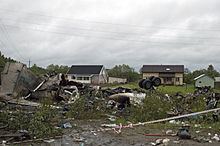Passengers 43 Fatalities 47 Date 20 June 2011 Injuries (nonfatal) 5 Survivor 5 | Crew 9 Survivors 5 Number of deaths 47 | |
 | ||
Summary Impacted road on approach to land by Pilot error (CFIT) Similar Hewa Bora Airways Flight 952, 2011 Royal Moroccan Air Force, Kolavia Flight 348, First Air Flight 6560, Iran Air Flight 277 | ||
Tu 134a 3 crash rusair flight 9605 ra 65691 memorial in petrozavodsk
RusAir Flight 9605 (also RusLine Flight 243) was a passenger flight which crashed near Petrozavodsk Airport, Petrozavodsk, Russia, on 20 June 2011. 47 of the 52 on board died. The aircraft involved, a Tupolev Tu-134A-3, was operating a RusAir scheduled domestic flight (as a RusLine service) from Domodedovo International Airport, Moscow, to Petrozavodsk. It crashed on approach in bad weather, coming down on A133 highway about 1,200 m (3,900 ft) short of the runway, shortly after 23:40 local time (19:40 UTC). As a result of the crash, all Tu-134s were to be withdrawn from commercial service in Russia.
Contents
- Tu 134a 3 crash rusair flight 9605 ra 65691 memorial in petrozavodsk
- Aircraft
- Incident
- Casualties
- Notable casualties
- Aftermath
- Investigation
- References
Aircraft
The aircraft involved was a Tupolev Tu-134A-3, registration RA-65691, c/n 63195. It was manufactured and first flown in 1980.
Incident
The aircraft crashed onto the A133 highway while on final approach to Petrozavodsk Airport, about 1,200 m (3,900 ft) short of the runway. The cause of the crash was not immediately clear. The crash happened about midnight local time in reportedly poor weather, including heavy fog and the aircraft had apparently attempted to land on the highway before crashing. The head of the federal air transport agency said the plane had hit a 15-metre (49 ft) tall pine tree before it crashed, adding that there was no fire or explosion on board the aircraft before the incident.
According to airport officials, the plane was flying off-course by about 200 metres (660 ft) and started its descent much earlier than appropriate. Petrozavodsk ground control said they recommended the pilots take a second approach due to the low visibility and bad weather conditions. The pilot, according to the official, replied that he would attempt the first approach and said he could land the plane. According to the office of the emergency ministry in Karelia, the republic in which the incident occurred, radio contact with the plane had been lost at 23:40 local time (19:40 UTC), shortly before the aircraft crashed.
Casualties
There were 43 passengers and nine crew members on board, a total of 52, of which 47 were killed and the remaining 5 injured. Of the survivors, one was a flight attendant. The other crew members were among the fatalities.
Three people who survived the initial crash later died of their injuries.
Notable casualties
FIFA football referee Vladimir Pettay was among the dead, as well the CEO and chief designer of Gidropress Sergei Ryzhov, and the deputy CEO and chief designer, Gennady Banyuk, also the chief designer of the Russian VVER-1000 for the Koodankulam Nuclear Power Plant in India and Bushehr Nuclear Power Plant in Iran, Nikolai Trunov.
Aftermath
By around 01:00 on 21 June, the fire at the crash site was extinguished. Those injured were initially sent to local hospitals, but it was planned to transport them on to Moscow via an Ilyushin Il-76 with doctors and psychologists on board.
On 23 June, at a conference of senior Russian government officials, it was announced that as a result of the incident the government planned to remove all Tu-134s from commercial service, as well as ban the operation of aircraft carrying more than nine people or weighing more than 5,700 kilograms (12,600 lb) lacking a ground proximity warning system.
Investigation
In September 2011, the report into the crash was published by the Interstate Aviation Committee. According to the committee, the primary cause of the incident was the refusal of the crew to perform a go-around and further descent below the minimum safe altitude in the absence of visual contact with the approach lights and landmarks, which led to collision with trees and terrain.
The contributing factors included:
